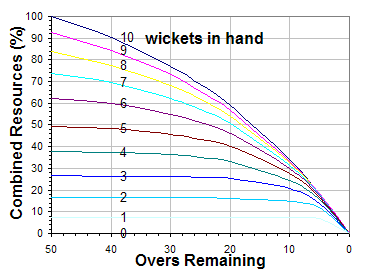Although the Duckworth-Lewis method is widely used in international and first class level there are many criticisms about this method.One of the main criticism about the DL method is that it gives a higher weight to number of wickets remaining rather than number of overs left. As an example DL par score jumped from 117 to 140 at the end of 20 overs when West Indies lose there 4th wicket in the 20th over at the recently concluded first ODI match between England and West Indies.WI were 1 run ahead before the wicket and suddenly 23 runs behind the target after the wicket.Thus it is very important to a chasing side, not to lose wickets rather than maintaining the required run rate.
Another problem with the DL method is it's inability to handle the power play overs.There is no way to account for the number of power play overs left and number of power play overs played. Also since it uses a G50 score concept where the average score was considered as 250 for an ODI match ,the target scores obtained by DL method was not very justifiable for very low scores and and for very high scores. Thus the effectiveness of the Duckworth-Lewis method is limited to a range of scores distributed around 250. Although this error was corrected for a certain extent in the professional edition still the Duckworth-Lewis method is not that accurate in lower scores and higher scores.
 |
| Duckworth-Lewis Curves |
Also when multiple interruptions happens the targets given by the Duckworth-Lewis have many anomalies. The target given by the Duckworth-Lewis method when the interruption happens during an innings break clearly favors the chasing side if the first innings score is high.This is because they have all the ten wickets in hand at the start and the number of overs are reduced. Due to this fact these days captains choose to field when they win the toss if rain is expected during the match.
Also Duckworth-Lewis method was originally designed for ODI matches. Thus when this was used in T20 matches it gives inefficient and unfair results. This may be because the lack of data to construct the resource curves for T20matches. In-fact the unsuitability of the Duckworth-Lewis method in T20 is the main criticism against it.
 |
| V. Jayadevan |
The designer of this method V. Jayadevan is currently working as an Engineer, Irrigation Department, Kerala. He has spent fifteen years to develop VJD system which is used for calculating revised target due to interruptions in ODI & T20 cricket matches, as an alternative to the existing D/L system.
Previous posts on Duckworth-Lewis method.

No comments:
Post a Comment